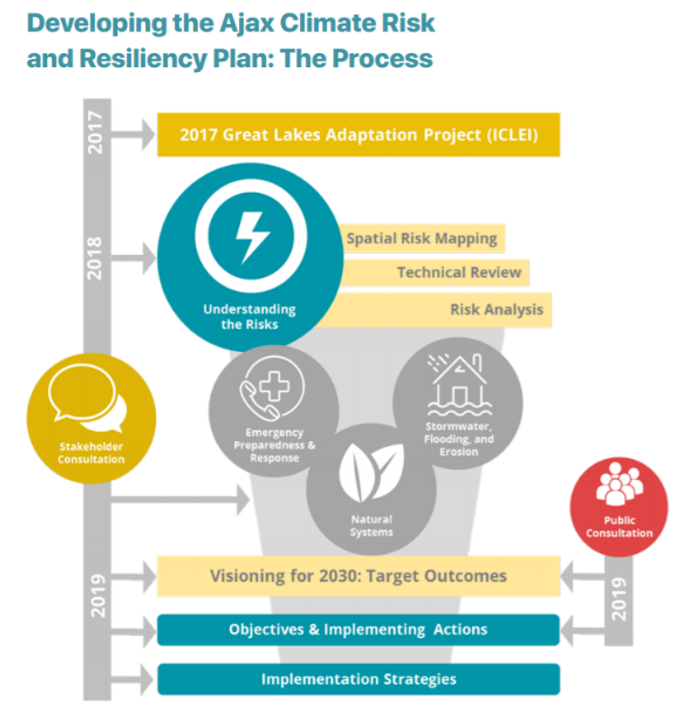Projects
Community Climate Study – Ajax, ON
The Town of Ajax identified a need to better understand the threats and risks faced by the community as a result of changing trends associated to the following three climate variables – severe weather, temperature and precipitation. The Dillon team assisted with the development of a community climate study to help the Town understand their potential risks.
Three main community outlooks were identified of particular concern to the Town and included overland and stormwater flooding, threats to the natural environment, and impacts to emergency preparedness and response services. The purpose of Town’s community climate study was to provide a GIS-based tool to assist in identifying, analyzing, evaluating and ultimately managing climate change based risks as part of an overall climate change adaptation plan being developed by the Town.
The natural capita assessment study performed for the Town identified and evaluated potential vulnerabilities of these natural capita assets in response to the bioclimatic condition predicted in the 2049 Durham Region climate model (SENES 2013, 2014). The study aimed to:
- Determine potential risks to urban trees and treed natural areas
- Identify areas susceptible to heat island effect
- Identify conflicts between trees with electrical and communication infrastructure
- Identify potential impacts of climate change to species at risk (SAR) and wildlife habitat
- Determine the susceptibility of drought of wetlands and other natural areas
- Determine responses of major diseases, pests and invasive species to climate change.
Overland and stormwater flooding are considered one of the key areas of concern for the Town. Understanding the areas of potential vulnerability within the town resulting from fluvial and pluvial flooding is crucial in developing an Overall Climate Change Adaptation plan for Ajax. One of the main areas of focus of the community climate study was to examine the performance of the storm sewer system during minor and major storm events (5-year, 25-year, 100-year storms) under two scenarios – current conditions and future climate change conditions. The study also focused on the magnitude of flooding for three main creeks within the town (Duffins Creek, Carruthers Creek, Lynde Creek) under the current and future climate change scenarios.

By combining the modelling results for flooding (fluvial and pluvial), a flood vulnerability map was generated, indicating areas where significant flooding is likely to occur under climate change. Identifying areas susceptible to flooding is necessary to determine locations for which a more detailed analysis may be required, and propose measures to mitigate these impacts that can be incorporated in the climate adaptation plan for the town.
The Emergency Response and Preparedness (ER&P) analysis aimed to identify and analyze the threats and risks faced by the Town of Ajax as a result of a changing climate. A vulnerability assessment was conducted around four key topics:
- Demographics
- Local partners and resources
- Vulnerable buildings
- Population density.
The analysis of community risks and vulnerability established the framework upon which a Climate Risk and Resiliency Plan (CRRP) was directly informed.
The CRRP identified and prioritized a list of actions that would need to be completed in order to ensure that the community could adapt to the threats posed by climate change. The plan was intended to directly support the Town of Ajax’s asset management plan and long-term budget forecast, as well as to help support stakeholders in their work to help ensure that climate change would have minimal impacts to the community.
Our engagement strategy for this project built upon the principles of the three horizons model, an approach designed for the purpose of creating transformational plans and actions by aligning stakeholders’ views toward systemic change toward a preferred future. Neither is right or wrong, but resilience aims to retain and manage current functional processes in the face of future risks, which requires defending current practices rather than planning to adapt to the uncertainty of a far term future. Transformation, as aided by Three Horizons, allowed stakeholders to think more creatively about future needs and outcomes. Because of the high uncertainty and complexity of climate change and adaptation outcomes over a 20-30 year period, the principles of the three horizons method proved useful within the stakeholder dialogues as a systemic model for identifying adaptation actions and building strategic adaptation pathways.
Project Details
Project Partner: Town of Ajax
Business Unit: Community Planning & Infrastructure
Service Offering: Community Planning